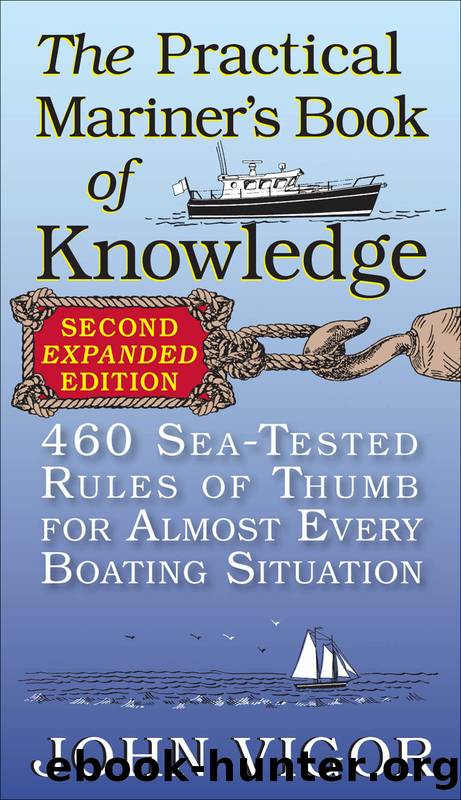The Practical Mariner's Book of Knowledge by John Vigor

Author:John Vigor
Language: eng
Format: epub
Publisher: McGraw-Hill Education
Published: 2013-08-14T16:00:00+00:00
Navigation Lights, Specifications for Fit the brightest lights for which you have power or battery capacity. Colored glass absorbs 85 to 90 percent of the light from the bulb.
With a 12-volt system and lights showing through clear glass or plastic in the most favorable weather conditions:
• A 24-watt bulb is visible at about three miles.
• A 12-watt bulb is visible at about two miles.
Showing through red or green glass or plastic in the most favorable weather conditions:
• A 24-watt bulb is visible at a little over 1 mile.
It is interesting to note that to increase visibility from 3 to 4 miles, the brightness of a lamp must be doubled.
Most lightbulbs on private sailboats are incandescent, despite the fact that several manufacturers have developed light-emitting diodes (LEDs) that meet Coast Guard requirements. These LEDs require much less power than incandescent bulbs, an important consideration for yachts with limited battery capacity, but are much more expensive than incandescents. For example, a typical incandescent masthead anchor-light fixture retailing for about $70 costs about $215 in an LED version. On the other hand, compared with a typical anchor-light incandescent bulb drawing 0.42 amps, an LED array draws only 0.2 amps for an equal light output. The use of LEDs both for navigation and interior lights will undoubtedly increase as increased sales volume and competition bring down manufacturing prices.
See also: ANCHOR LIGHT, REQUIRED SIZE
Download
This site does not store any files on its server. We only index and link to content provided by other sites. Please contact the content providers to delete copyright contents if any and email us, we'll remove relevant links or contents immediately.
| Automotive | Engineering |
| Transportation |
Whiskies Galore by Ian Buxton(41529)
Introduction to Aircraft Design (Cambridge Aerospace Series) by John P. Fielding(32888)
Small Unmanned Fixed-wing Aircraft Design by Andrew J. Keane Andras Sobester James P. Scanlan & András Sóbester & James P. Scanlan(32573)
Craft Beer for the Homebrewer by Michael Agnew(17932)
Turbulence by E. J. Noyes(7700)
The Complete Stick Figure Physics Tutorials by Allen Sarah(7137)
Kaplan MCAT General Chemistry Review by Kaplan(6595)
The Thirst by Nesbo Jo(6435)
Bad Blood by John Carreyrou(6274)
Modelling of Convective Heat and Mass Transfer in Rotating Flows by Igor V. Shevchuk(6222)
Learning SQL by Alan Beaulieu(6035)
Weapons of Math Destruction by Cathy O'Neil(5827)
Man-made Catastrophes and Risk Information Concealment by Dmitry Chernov & Didier Sornette(5645)
Digital Minimalism by Cal Newport;(5389)
Life 3.0: Being Human in the Age of Artificial Intelligence by Tegmark Max(5184)
iGen by Jean M. Twenge(5161)
Secrets of Antigravity Propulsion: Tesla, UFOs, and Classified Aerospace Technology by Ph.D. Paul A. Laviolette(4989)
Design of Trajectory Optimization Approach for Space Maneuver Vehicle Skip Entry Problems by Runqi Chai & Al Savvaris & Antonios Tsourdos & Senchun Chai(4839)
Electronic Devices & Circuits by Jacob Millman & Christos C. Halkias(4746)
